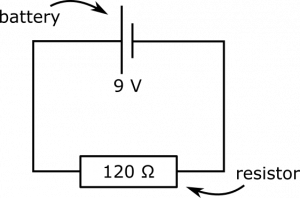This is an old revision of the document!
Example: Application of Ohm's Law
Suppose you have a simple circuit that contains only a 9-Volt battery and a resistor of $120 \Omega$. What is the current in the wire?
Facts
- $\Delta V = 9\text{ V}$
- $R = 120 \Omega$
Lacking
- Current
Approximations & Assumptions
- The wire has no (negligible) resistance.
- The circuit is in a steady state.
- Approximating the battery as a mechanical battery.
- There is no outside influence on the circuit.
Representations
- We represent Ohm's Law as $\Delta V = IR$.
- We represent the situation with following picture.
Solution
We have assumed that the battery and the wire contribute negligible resistance to the circuit. So the resistance of the circuit is simply the resistance of the resistor: $R = 120\Omega$. These assumptions also lead us to conclude that the voltage difference across the circuit (from the positive end of the battery to the negative end) is the entire 9 Volts, so $\Delta V = 9 \text{ V}$. We can now use Ohm's Law to find the current through the circuit: $$I = \frac{\Delta V}{R} = 75 \text{ mA}$$
